Analysis of Organizational Change: Leadership and Strategies
VerifiedAdded on 2021/01/02
|16
|4902
|415
Report
AI Summary
This report examines the impact of change on organizational operations and strategy, focusing on the UK mobile network operators EE and Vodafone. It explores the internal and external drivers of change, including pricing strategies, external environment analysis, and structural changes, highlighting how these factors influence team, individual, and leadership behaviors. The report also delves into the barriers to change and their influence on leadership decision-making, as well as the contributions of different leadership approaches, particularly transformational leadership, in managing organizational change. Furthermore, it analyzes the measures taken to minimize the impact of change on organizational behavior using the Burkin Litwin Model of change management. The report provides real-world examples and case studies to illustrate the concepts discussed, offering valuable insights into change management and leadership practices in dynamic business environments.
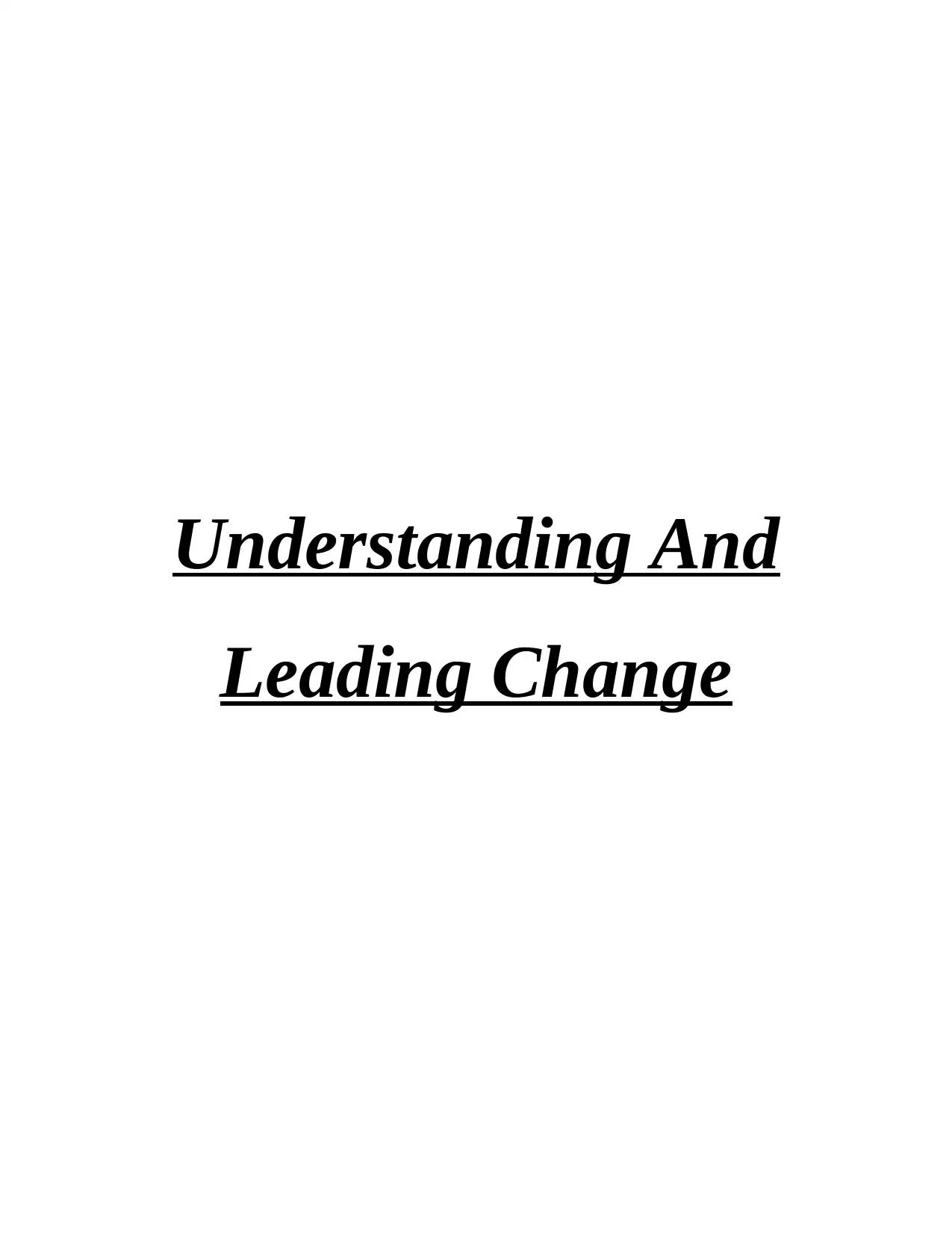
Understanding And
Leading Change
Leading Change
Paraphrase This Document
Need a fresh take? Get an instant paraphrase of this document with our AI Paraphraser
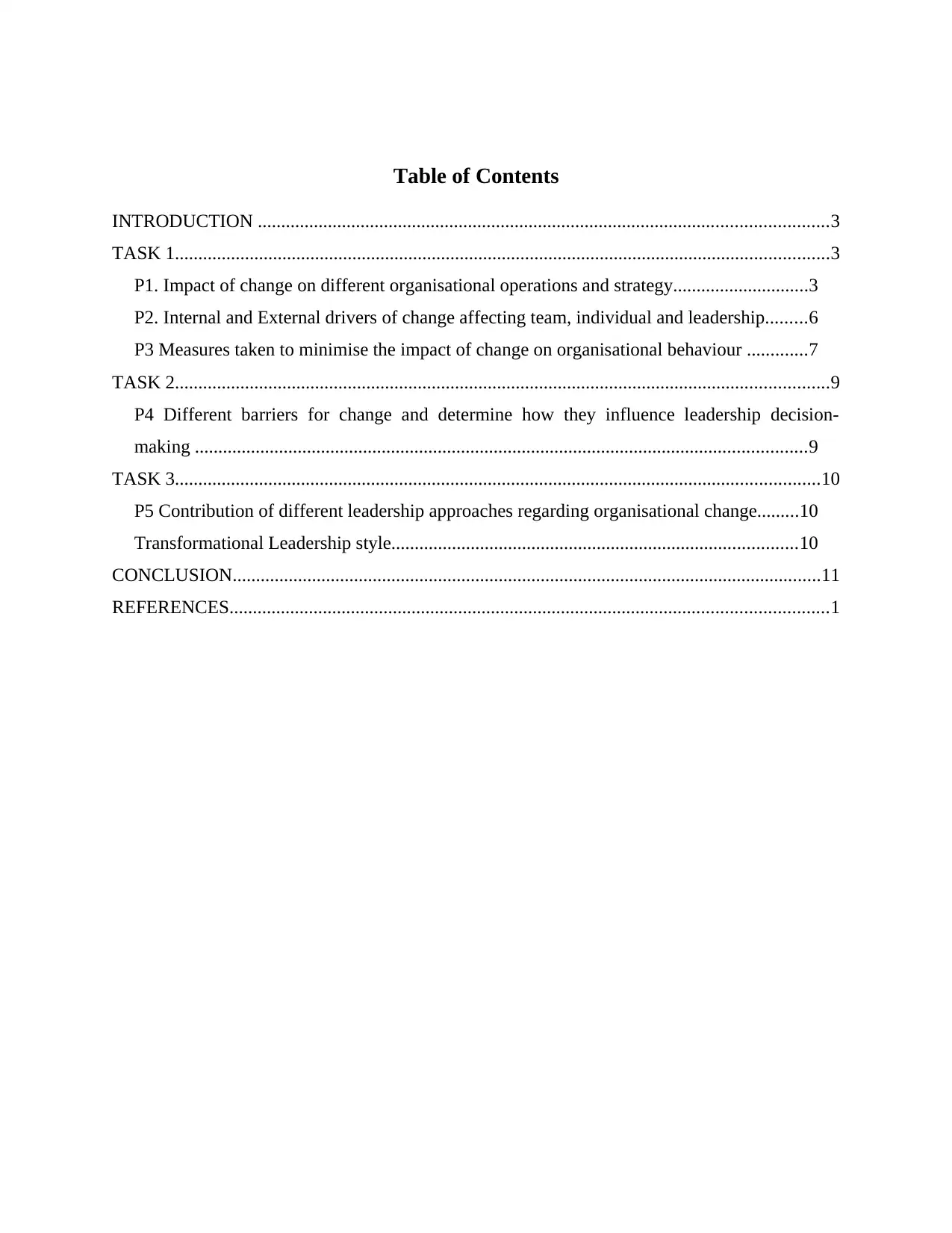
Table of Contents
INTRODUCTION ..........................................................................................................................3
TASK 1............................................................................................................................................3
P1. Impact of change on different organisational operations and strategy.............................3
P2. Internal and External drivers of change affecting team, individual and leadership.........6
P3 Measures taken to minimise the impact of change on organisational behaviour .............7
TASK 2............................................................................................................................................9
P4 Different barriers for change and determine how they influence leadership decision-
making ...................................................................................................................................9
TASK 3..........................................................................................................................................10
P5 Contribution of different leadership approaches regarding organisational change.........10
Transformational Leadership style.......................................................................................10
CONCLUSION..............................................................................................................................11
REFERENCES................................................................................................................................1
INTRODUCTION ..........................................................................................................................3
TASK 1............................................................................................................................................3
P1. Impact of change on different organisational operations and strategy.............................3
P2. Internal and External drivers of change affecting team, individual and leadership.........6
P3 Measures taken to minimise the impact of change on organisational behaviour .............7
TASK 2............................................................................................................................................9
P4 Different barriers for change and determine how they influence leadership decision-
making ...................................................................................................................................9
TASK 3..........................................................................................................................................10
P5 Contribution of different leadership approaches regarding organisational change.........10
Transformational Leadership style.......................................................................................10
CONCLUSION..............................................................................................................................11
REFERENCES................................................................................................................................1
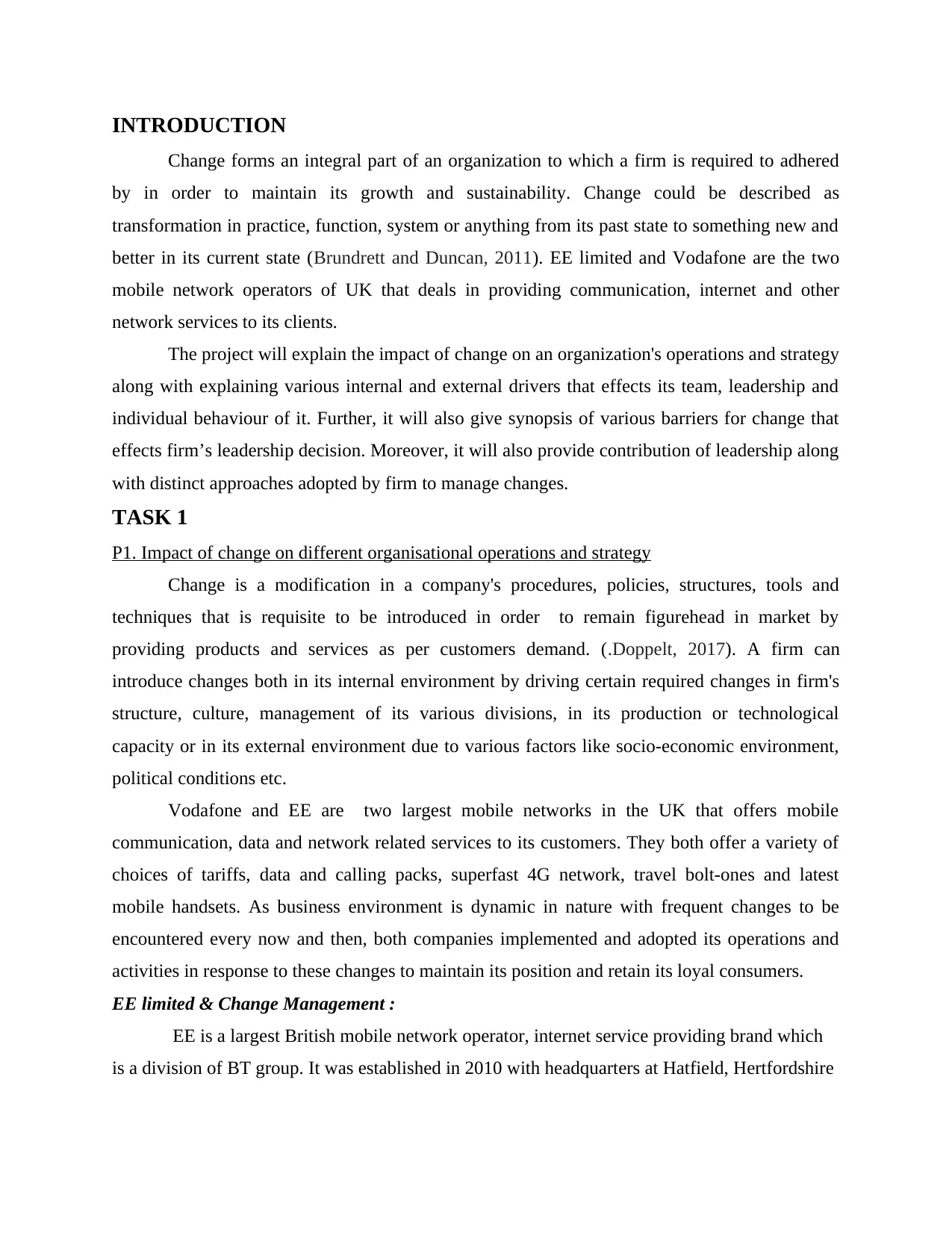
INTRODUCTION
Change forms an integral part of an organization to which a firm is required to adhered
by in order to maintain its growth and sustainability. Change could be described as
transformation in practice, function, system or anything from its past state to something new and
better in its current state (Brundrett and Duncan, 2011). EE limited and Vodafone are the two
mobile network operators of UK that deals in providing communication, internet and other
network services to its clients.
The project will explain the impact of change on an organization's operations and strategy
along with explaining various internal and external drivers that effects its team, leadership and
individual behaviour of it. Further, it will also give synopsis of various barriers for change that
effects firm’s leadership decision. Moreover, it will also provide contribution of leadership along
with distinct approaches adopted by firm to manage changes.
TASK 1
P1. Impact of change on different organisational operations and strategy
Change is a modification in a company's procedures, policies, structures, tools and
techniques that is requisite to be introduced in order to remain figurehead in market by
providing products and services as per customers demand. (.Doppelt, 2017). A firm can
introduce changes both in its internal environment by driving certain required changes in firm's
structure, culture, management of its various divisions, in its production or technological
capacity or in its external environment due to various factors like socio-economic environment,
political conditions etc.
Vodafone and EE are two largest mobile networks in the UK that offers mobile
communication, data and network related services to its customers. They both offer a variety of
choices of tariffs, data and calling packs, superfast 4G network, travel bolt-ones and latest
mobile handsets. As business environment is dynamic in nature with frequent changes to be
encountered every now and then, both companies implemented and adopted its operations and
activities in response to these changes to maintain its position and retain its loyal consumers.
EE limited & Change Management :
EE is a largest British mobile network operator, internet service providing brand which
is a division of BT group. It was established in 2010 with headquarters at Hatfield, Hertfordshire
Change forms an integral part of an organization to which a firm is required to adhered
by in order to maintain its growth and sustainability. Change could be described as
transformation in practice, function, system or anything from its past state to something new and
better in its current state (Brundrett and Duncan, 2011). EE limited and Vodafone are the two
mobile network operators of UK that deals in providing communication, internet and other
network services to its clients.
The project will explain the impact of change on an organization's operations and strategy
along with explaining various internal and external drivers that effects its team, leadership and
individual behaviour of it. Further, it will also give synopsis of various barriers for change that
effects firm’s leadership decision. Moreover, it will also provide contribution of leadership along
with distinct approaches adopted by firm to manage changes.
TASK 1
P1. Impact of change on different organisational operations and strategy
Change is a modification in a company's procedures, policies, structures, tools and
techniques that is requisite to be introduced in order to remain figurehead in market by
providing products and services as per customers demand. (.Doppelt, 2017). A firm can
introduce changes both in its internal environment by driving certain required changes in firm's
structure, culture, management of its various divisions, in its production or technological
capacity or in its external environment due to various factors like socio-economic environment,
political conditions etc.
Vodafone and EE are two largest mobile networks in the UK that offers mobile
communication, data and network related services to its customers. They both offer a variety of
choices of tariffs, data and calling packs, superfast 4G network, travel bolt-ones and latest
mobile handsets. As business environment is dynamic in nature with frequent changes to be
encountered every now and then, both companies implemented and adopted its operations and
activities in response to these changes to maintain its position and retain its loyal consumers.
EE limited & Change Management :
EE is a largest British mobile network operator, internet service providing brand which
is a division of BT group. It was established in 2010 with headquarters at Hatfield, Hertfordshire
⊘ This is a preview!⊘
Do you want full access?
Subscribe today to unlock all pages.

Trusted by 1+ million students worldwide
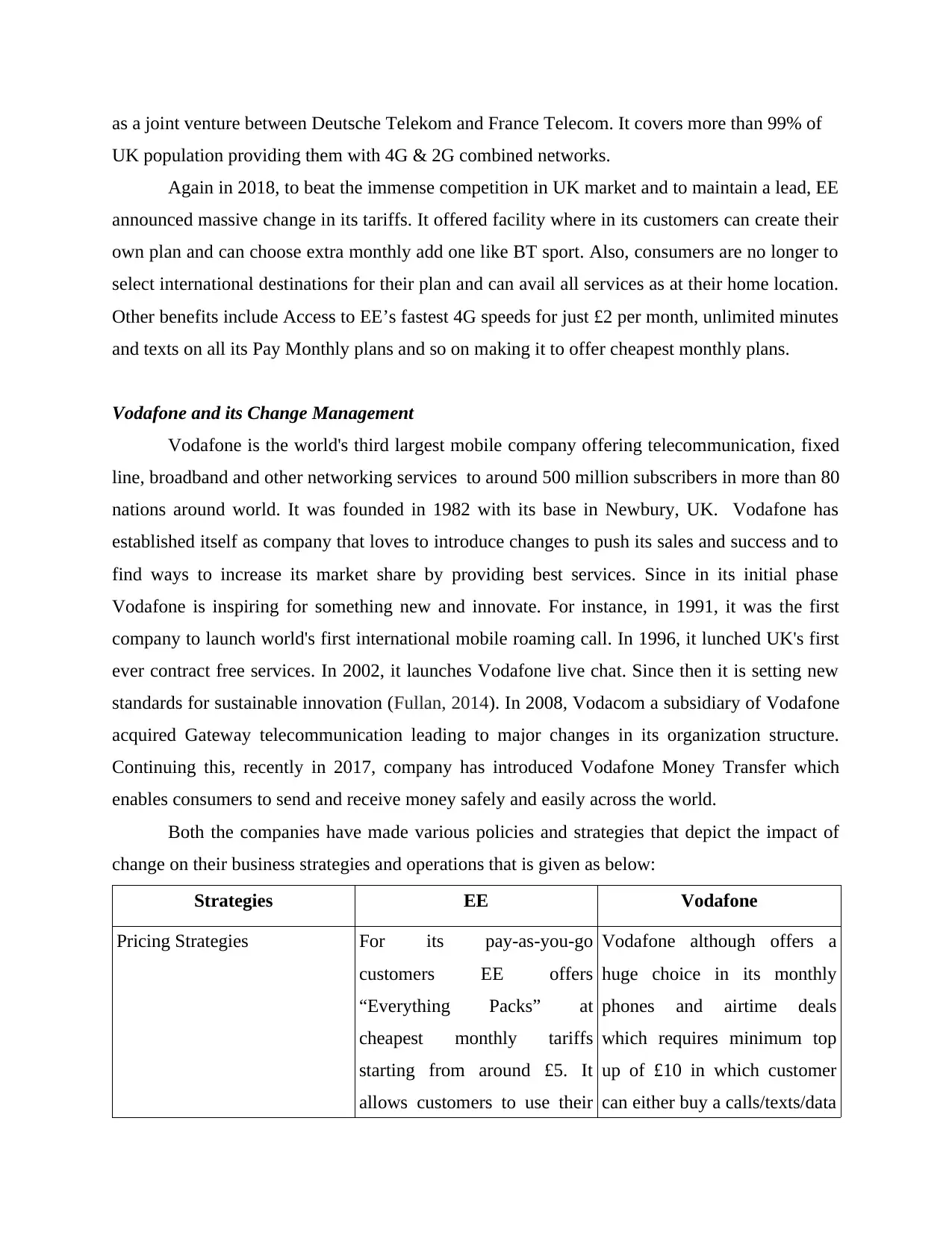
as a joint venture between Deutsche Telekom and France Telecom. It covers more than 99% of
UK population providing them with 4G & 2G combined networks.
Again in 2018, to beat the immense competition in UK market and to maintain a lead, EE
announced massive change in its tariffs. It offered facility where in its customers can create their
own plan and can choose extra monthly add one like BT sport. Also, consumers are no longer to
select international destinations for their plan and can avail all services as at their home location.
Other benefits include Access to EE’s fastest 4G speeds for just £2 per month, unlimited minutes
and texts on all its Pay Monthly plans and so on making it to offer cheapest monthly plans.
Vodafone and its Change Management
Vodafone is the world's third largest mobile company offering telecommunication, fixed
line, broadband and other networking services to around 500 million subscribers in more than 80
nations around world. It was founded in 1982 with its base in Newbury, UK. Vodafone has
established itself as company that loves to introduce changes to push its sales and success and to
find ways to increase its market share by providing best services. Since in its initial phase
Vodafone is inspiring for something new and innovate. For instance, in 1991, it was the first
company to launch world's first international mobile roaming call. In 1996, it lunched UK's first
ever contract free services. In 2002, it launches Vodafone live chat. Since then it is setting new
standards for sustainable innovation (Fullan, 2014). In 2008, Vodacom a subsidiary of Vodafone
acquired Gateway telecommunication leading to major changes in its organization structure.
Continuing this, recently in 2017, company has introduced Vodafone Money Transfer which
enables consumers to send and receive money safely and easily across the world.
Both the companies have made various policies and strategies that depict the impact of
change on their business strategies and operations that is given as below:
Strategies EE Vodafone
Pricing Strategies For its pay-as-you-go
customers EE offers
“Everything Packs” at
cheapest monthly tariffs
starting from around £5. It
allows customers to use their
Vodafone although offers a
huge choice in its monthly
phones and airtime deals
which requires minimum top
up of £10 in which customer
can either buy a calls/texts/data
UK population providing them with 4G & 2G combined networks.
Again in 2018, to beat the immense competition in UK market and to maintain a lead, EE
announced massive change in its tariffs. It offered facility where in its customers can create their
own plan and can choose extra monthly add one like BT sport. Also, consumers are no longer to
select international destinations for their plan and can avail all services as at their home location.
Other benefits include Access to EE’s fastest 4G speeds for just £2 per month, unlimited minutes
and texts on all its Pay Monthly plans and so on making it to offer cheapest monthly plans.
Vodafone and its Change Management
Vodafone is the world's third largest mobile company offering telecommunication, fixed
line, broadband and other networking services to around 500 million subscribers in more than 80
nations around world. It was founded in 1982 with its base in Newbury, UK. Vodafone has
established itself as company that loves to introduce changes to push its sales and success and to
find ways to increase its market share by providing best services. Since in its initial phase
Vodafone is inspiring for something new and innovate. For instance, in 1991, it was the first
company to launch world's first international mobile roaming call. In 1996, it lunched UK's first
ever contract free services. In 2002, it launches Vodafone live chat. Since then it is setting new
standards for sustainable innovation (Fullan, 2014). In 2008, Vodacom a subsidiary of Vodafone
acquired Gateway telecommunication leading to major changes in its organization structure.
Continuing this, recently in 2017, company has introduced Vodafone Money Transfer which
enables consumers to send and receive money safely and easily across the world.
Both the companies have made various policies and strategies that depict the impact of
change on their business strategies and operations that is given as below:
Strategies EE Vodafone
Pricing Strategies For its pay-as-you-go
customers EE offers
“Everything Packs” at
cheapest monthly tariffs
starting from around £5. It
allows customers to use their
Vodafone although offers a
huge choice in its monthly
phones and airtime deals
which requires minimum top
up of £10 in which customer
can either buy a calls/texts/data
Paraphrase This Document
Need a fresh take? Get an instant paraphrase of this document with our AI Paraphraser
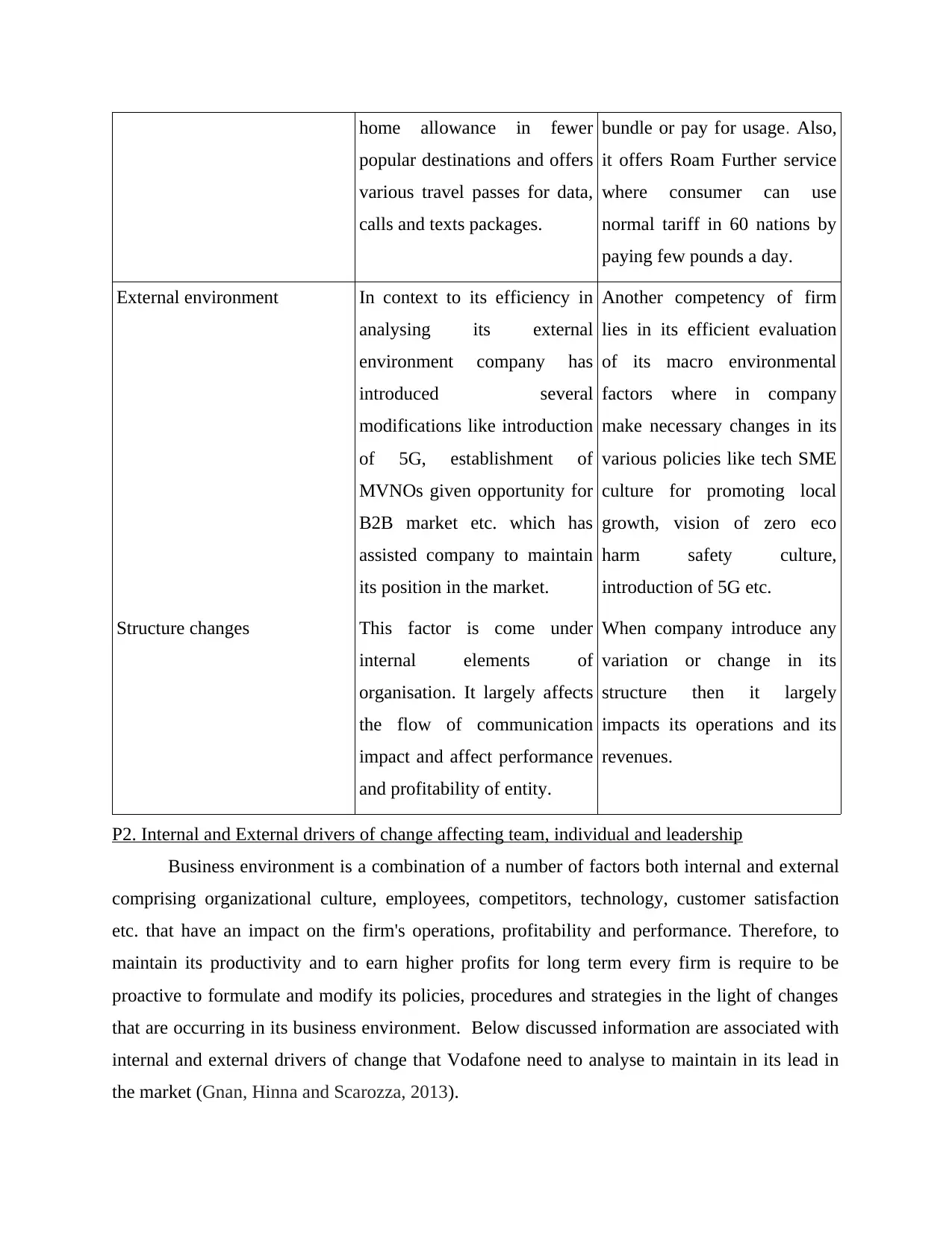
home allowance in fewer
popular destinations and offers
various travel passes for data,
calls and texts packages.
bundle or pay for usage. Also,
it offers Roam Further service
where consumer can use
normal tariff in 60 nations by
paying few pounds a day.
External environment In context to its efficiency in
analysing its external
environment company has
introduced several
modifications like introduction
of 5G, establishment of
MVNOs given opportunity for
B2B market etc. which has
assisted company to maintain
its position in the market.
Another competency of firm
lies in its efficient evaluation
of its macro environmental
factors where in company
make necessary changes in its
various policies like tech SME
culture for promoting local
growth, vision of zero eco
harm safety culture,
introduction of 5G etc.
Structure changes This factor is come under
internal elements of
organisation. It largely affects
the flow of communication
impact and affect performance
and profitability of entity.
When company introduce any
variation or change in its
structure then it largely
impacts its operations and its
revenues.
P2. Internal and External drivers of change affecting team, individual and leadership
Business environment is a combination of a number of factors both internal and external
comprising organizational culture, employees, competitors, technology, customer satisfaction
etc. that have an impact on the firm's operations, profitability and performance. Therefore, to
maintain its productivity and to earn higher profits for long term every firm is require to be
proactive to formulate and modify its policies, procedures and strategies in the light of changes
that are occurring in its business environment. Below discussed information are associated with
internal and external drivers of change that Vodafone need to analyse to maintain in its lead in
the market (Gnan, Hinna and Scarozza, 2013).
popular destinations and offers
various travel passes for data,
calls and texts packages.
bundle or pay for usage. Also,
it offers Roam Further service
where consumer can use
normal tariff in 60 nations by
paying few pounds a day.
External environment In context to its efficiency in
analysing its external
environment company has
introduced several
modifications like introduction
of 5G, establishment of
MVNOs given opportunity for
B2B market etc. which has
assisted company to maintain
its position in the market.
Another competency of firm
lies in its efficient evaluation
of its macro environmental
factors where in company
make necessary changes in its
various policies like tech SME
culture for promoting local
growth, vision of zero eco
harm safety culture,
introduction of 5G etc.
Structure changes This factor is come under
internal elements of
organisation. It largely affects
the flow of communication
impact and affect performance
and profitability of entity.
When company introduce any
variation or change in its
structure then it largely
impacts its operations and its
revenues.
P2. Internal and External drivers of change affecting team, individual and leadership
Business environment is a combination of a number of factors both internal and external
comprising organizational culture, employees, competitors, technology, customer satisfaction
etc. that have an impact on the firm's operations, profitability and performance. Therefore, to
maintain its productivity and to earn higher profits for long term every firm is require to be
proactive to formulate and modify its policies, procedures and strategies in the light of changes
that are occurring in its business environment. Below discussed information are associated with
internal and external drivers of change that Vodafone need to analyse to maintain in its lead in
the market (Gnan, Hinna and Scarozza, 2013).
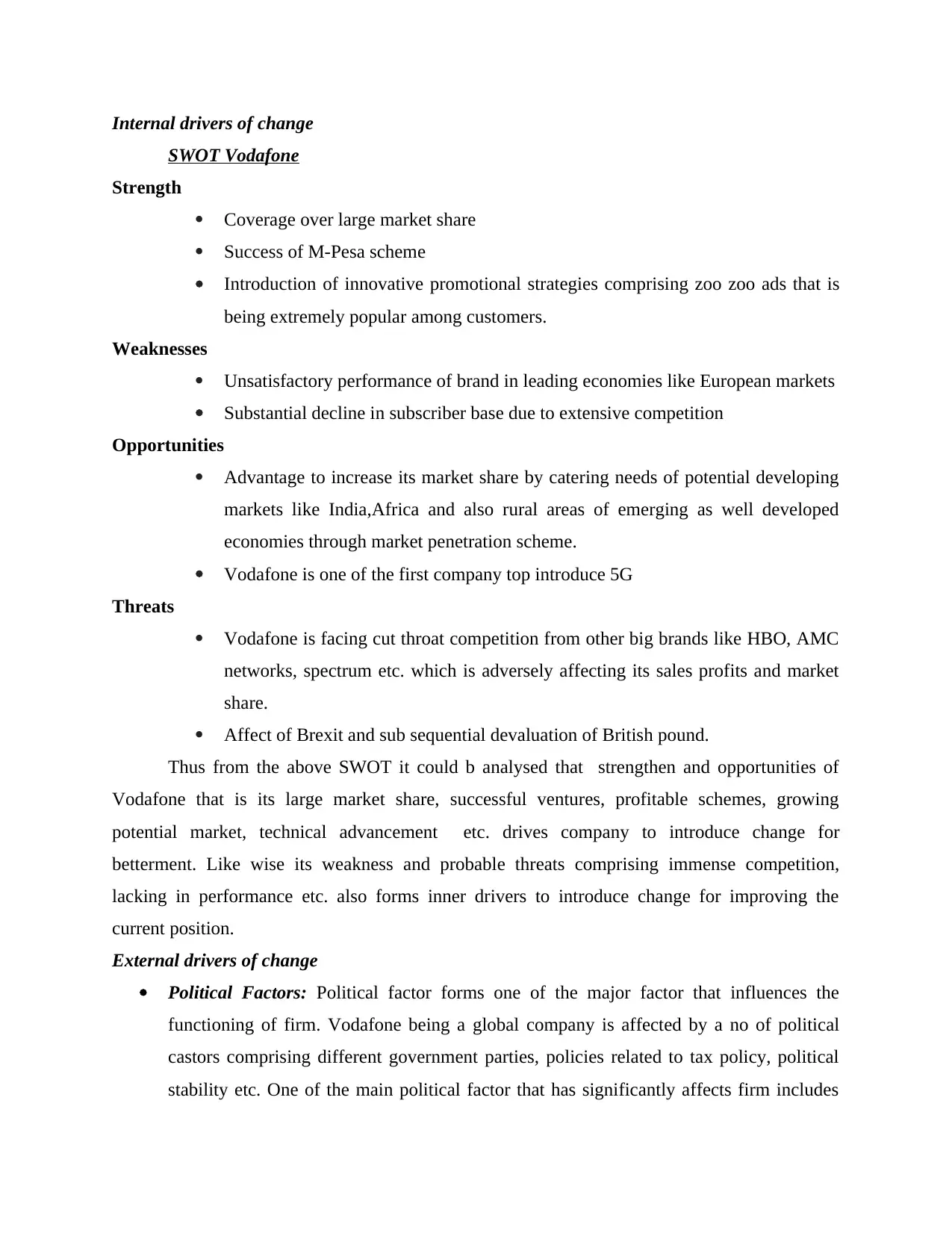
Internal drivers of change
SWOT Vodafone
Strength
Coverage over large market share
Success of M-Pesa scheme
Introduction of innovative promotional strategies comprising zoo zoo ads that is
being extremely popular among customers.
Weaknesses
Unsatisfactory performance of brand in leading economies like European markets
Substantial decline in subscriber base due to extensive competition
Opportunities
Advantage to increase its market share by catering needs of potential developing
markets like India,Africa and also rural areas of emerging as well developed
economies through market penetration scheme.
Vodafone is one of the first company top introduce 5G
Threats
Vodafone is facing cut throat competition from other big brands like HBO, AMC
networks, spectrum etc. which is adversely affecting its sales profits and market
share.
Affect of Brexit and sub sequential devaluation of British pound.
Thus from the above SWOT it could b analysed that strengthen and opportunities of
Vodafone that is its large market share, successful ventures, profitable schemes, growing
potential market, technical advancement etc. drives company to introduce change for
betterment. Like wise its weakness and probable threats comprising immense competition,
lacking in performance etc. also forms inner drivers to introduce change for improving the
current position.
External drivers of change
Political Factors: Political factor forms one of the major factor that influences the
functioning of firm. Vodafone being a global company is affected by a no of political
castors comprising different government parties, policies related to tax policy, political
stability etc. One of the main political factor that has significantly affects firm includes
SWOT Vodafone
Strength
Coverage over large market share
Success of M-Pesa scheme
Introduction of innovative promotional strategies comprising zoo zoo ads that is
being extremely popular among customers.
Weaknesses
Unsatisfactory performance of brand in leading economies like European markets
Substantial decline in subscriber base due to extensive competition
Opportunities
Advantage to increase its market share by catering needs of potential developing
markets like India,Africa and also rural areas of emerging as well developed
economies through market penetration scheme.
Vodafone is one of the first company top introduce 5G
Threats
Vodafone is facing cut throat competition from other big brands like HBO, AMC
networks, spectrum etc. which is adversely affecting its sales profits and market
share.
Affect of Brexit and sub sequential devaluation of British pound.
Thus from the above SWOT it could b analysed that strengthen and opportunities of
Vodafone that is its large market share, successful ventures, profitable schemes, growing
potential market, technical advancement etc. drives company to introduce change for
betterment. Like wise its weakness and probable threats comprising immense competition,
lacking in performance etc. also forms inner drivers to introduce change for improving the
current position.
External drivers of change
Political Factors: Political factor forms one of the major factor that influences the
functioning of firm. Vodafone being a global company is affected by a no of political
castors comprising different government parties, policies related to tax policy, political
stability etc. One of the main political factor that has significantly affects firm includes
⊘ This is a preview!⊘
Do you want full access?
Subscribe today to unlock all pages.

Trusted by 1+ million students worldwide
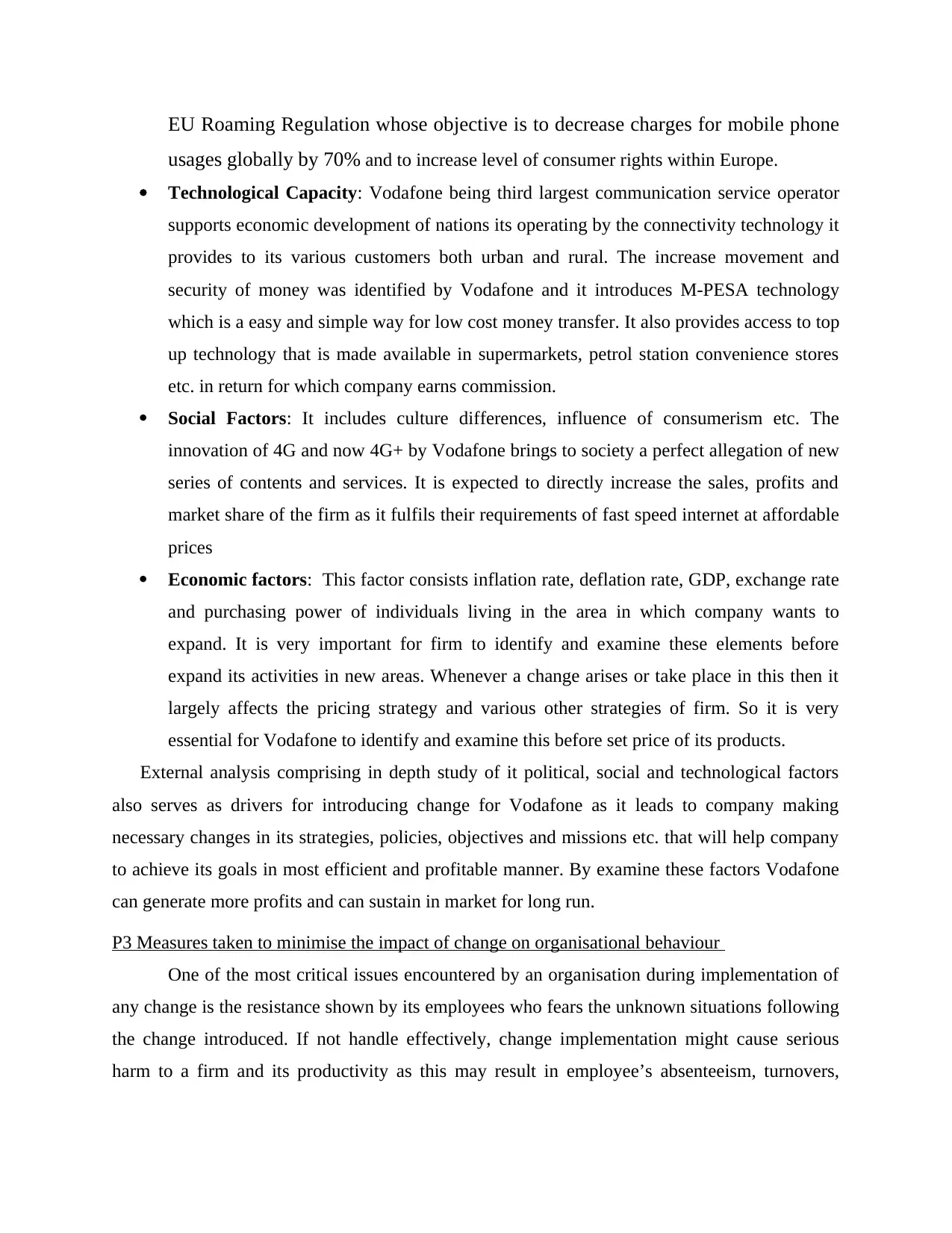
EU Roaming Regulation whose objective is to decrease charges for mobile phone
usages globally by 70% and to increase level of consumer rights within Europe.
Technological Capacity: Vodafone being third largest communication service operator
supports economic development of nations its operating by the connectivity technology it
provides to its various customers both urban and rural. The increase movement and
security of money was identified by Vodafone and it introduces M-PESA technology
which is a easy and simple way for low cost money transfer. It also provides access to top
up technology that is made available in supermarkets, petrol station convenience stores
etc. in return for which company earns commission.
Social Factors: It includes culture differences, influence of consumerism etc. The
innovation of 4G and now 4G+ by Vodafone brings to society a perfect allegation of new
series of contents and services. It is expected to directly increase the sales, profits and
market share of the firm as it fulfils their requirements of fast speed internet at affordable
prices
Economic factors: This factor consists inflation rate, deflation rate, GDP, exchange rate
and purchasing power of individuals living in the area in which company wants to
expand. It is very important for firm to identify and examine these elements before
expand its activities in new areas. Whenever a change arises or take place in this then it
largely affects the pricing strategy and various other strategies of firm. So it is very
essential for Vodafone to identify and examine this before set price of its products.
External analysis comprising in depth study of it political, social and technological factors
also serves as drivers for introducing change for Vodafone as it leads to company making
necessary changes in its strategies, policies, objectives and missions etc. that will help company
to achieve its goals in most efficient and profitable manner. By examine these factors Vodafone
can generate more profits and can sustain in market for long run.
P3 Measures taken to minimise the impact of change on organisational behaviour
One of the most critical issues encountered by an organisation during implementation of
any change is the resistance shown by its employees who fears the unknown situations following
the change introduced. If not handle effectively, change implementation might cause serious
harm to a firm and its productivity as this may result in employee’s absenteeism, turnovers,
usages globally by 70% and to increase level of consumer rights within Europe.
Technological Capacity: Vodafone being third largest communication service operator
supports economic development of nations its operating by the connectivity technology it
provides to its various customers both urban and rural. The increase movement and
security of money was identified by Vodafone and it introduces M-PESA technology
which is a easy and simple way for low cost money transfer. It also provides access to top
up technology that is made available in supermarkets, petrol station convenience stores
etc. in return for which company earns commission.
Social Factors: It includes culture differences, influence of consumerism etc. The
innovation of 4G and now 4G+ by Vodafone brings to society a perfect allegation of new
series of contents and services. It is expected to directly increase the sales, profits and
market share of the firm as it fulfils their requirements of fast speed internet at affordable
prices
Economic factors: This factor consists inflation rate, deflation rate, GDP, exchange rate
and purchasing power of individuals living in the area in which company wants to
expand. It is very important for firm to identify and examine these elements before
expand its activities in new areas. Whenever a change arises or take place in this then it
largely affects the pricing strategy and various other strategies of firm. So it is very
essential for Vodafone to identify and examine this before set price of its products.
External analysis comprising in depth study of it political, social and technological factors
also serves as drivers for introducing change for Vodafone as it leads to company making
necessary changes in its strategies, policies, objectives and missions etc. that will help company
to achieve its goals in most efficient and profitable manner. By examine these factors Vodafone
can generate more profits and can sustain in market for long run.
P3 Measures taken to minimise the impact of change on organisational behaviour
One of the most critical issues encountered by an organisation during implementation of
any change is the resistance shown by its employees who fears the unknown situations following
the change introduced. If not handle effectively, change implementation might cause serious
harm to a firm and its productivity as this may result in employee’s absenteeism, turnovers,
Paraphrase This Document
Need a fresh take? Get an instant paraphrase of this document with our AI Paraphraser
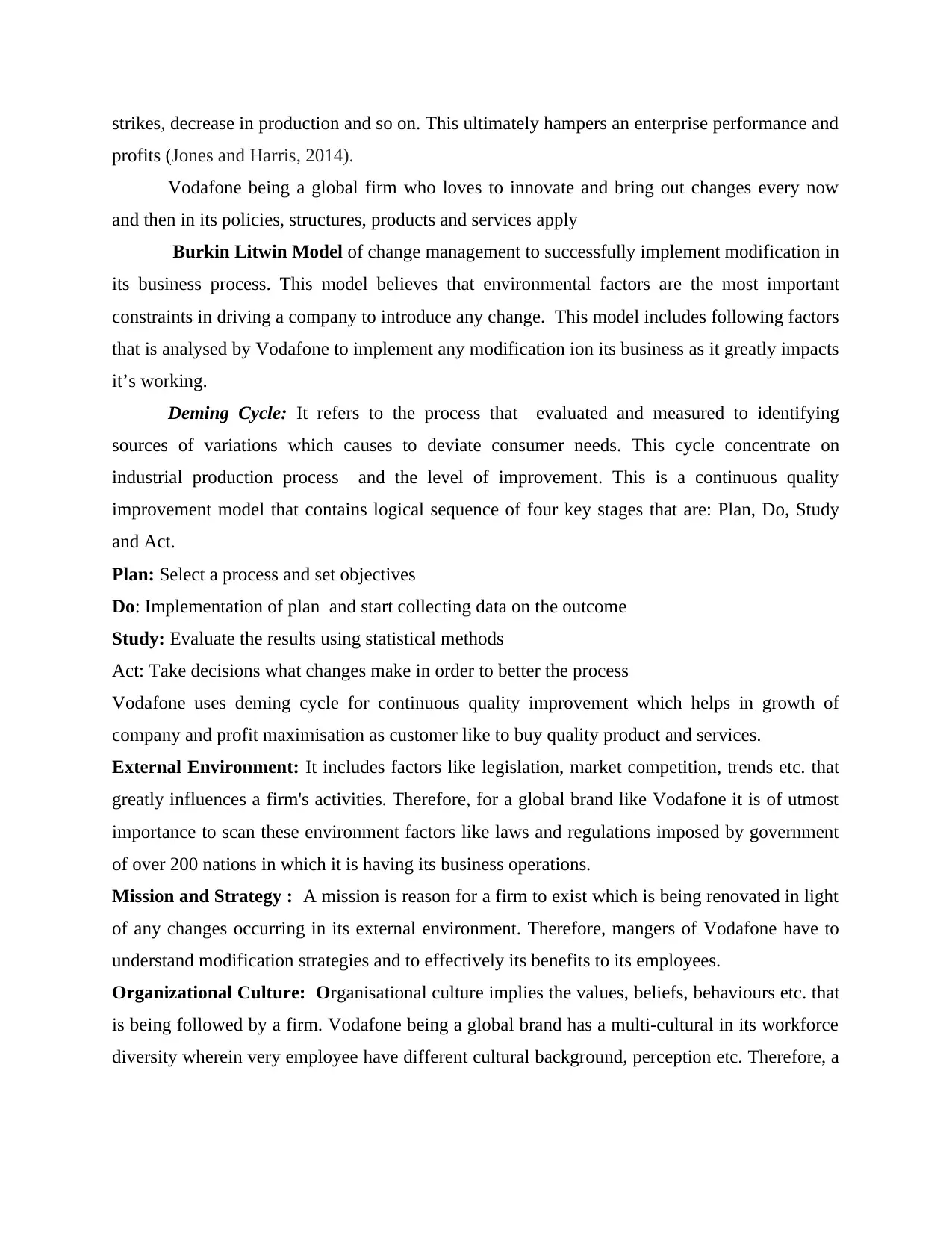
strikes, decrease in production and so on. This ultimately hampers an enterprise performance and
profits (Jones and Harris, 2014).
Vodafone being a global firm who loves to innovate and bring out changes every now
and then in its policies, structures, products and services apply
Burkin Litwin Model of change management to successfully implement modification in
its business process. This model believes that environmental factors are the most important
constraints in driving a company to introduce any change. This model includes following factors
that is analysed by Vodafone to implement any modification ion its business as it greatly impacts
it’s working.
Deming Cycle: It refers to the process that evaluated and measured to identifying
sources of variations which causes to deviate consumer needs. This cycle concentrate on
industrial production process and the level of improvement. This is a continuous quality
improvement model that contains logical sequence of four key stages that are: Plan, Do, Study
and Act.
Plan: Select a process and set objectives
Do: Implementation of plan and start collecting data on the outcome
Study: Evaluate the results using statistical methods
Act: Take decisions what changes make in order to better the process
Vodafone uses deming cycle for continuous quality improvement which helps in growth of
company and profit maximisation as customer like to buy quality product and services.
External Environment: It includes factors like legislation, market competition, trends etc. that
greatly influences a firm's activities. Therefore, for a global brand like Vodafone it is of utmost
importance to scan these environment factors like laws and regulations imposed by government
of over 200 nations in which it is having its business operations.
Mission and Strategy : A mission is reason for a firm to exist which is being renovated in light
of any changes occurring in its external environment. Therefore, mangers of Vodafone have to
understand modification strategies and to effectively its benefits to its employees.
Organizational Culture: Organisational culture implies the values, beliefs, behaviours etc. that
is being followed by a firm. Vodafone being a global brand has a multi-cultural in its workforce
diversity wherein very employee have different cultural background, perception etc. Therefore, a
profits (Jones and Harris, 2014).
Vodafone being a global firm who loves to innovate and bring out changes every now
and then in its policies, structures, products and services apply
Burkin Litwin Model of change management to successfully implement modification in
its business process. This model believes that environmental factors are the most important
constraints in driving a company to introduce any change. This model includes following factors
that is analysed by Vodafone to implement any modification ion its business as it greatly impacts
it’s working.
Deming Cycle: It refers to the process that evaluated and measured to identifying
sources of variations which causes to deviate consumer needs. This cycle concentrate on
industrial production process and the level of improvement. This is a continuous quality
improvement model that contains logical sequence of four key stages that are: Plan, Do, Study
and Act.
Plan: Select a process and set objectives
Do: Implementation of plan and start collecting data on the outcome
Study: Evaluate the results using statistical methods
Act: Take decisions what changes make in order to better the process
Vodafone uses deming cycle for continuous quality improvement which helps in growth of
company and profit maximisation as customer like to buy quality product and services.
External Environment: It includes factors like legislation, market competition, trends etc. that
greatly influences a firm's activities. Therefore, for a global brand like Vodafone it is of utmost
importance to scan these environment factors like laws and regulations imposed by government
of over 200 nations in which it is having its business operations.
Mission and Strategy : A mission is reason for a firm to exist which is being renovated in light
of any changes occurring in its external environment. Therefore, mangers of Vodafone have to
understand modification strategies and to effectively its benefits to its employees.
Organizational Culture: Organisational culture implies the values, beliefs, behaviours etc. that
is being followed by a firm. Vodafone being a global brand has a multi-cultural in its workforce
diversity wherein very employee have different cultural background, perception etc. Therefore, a
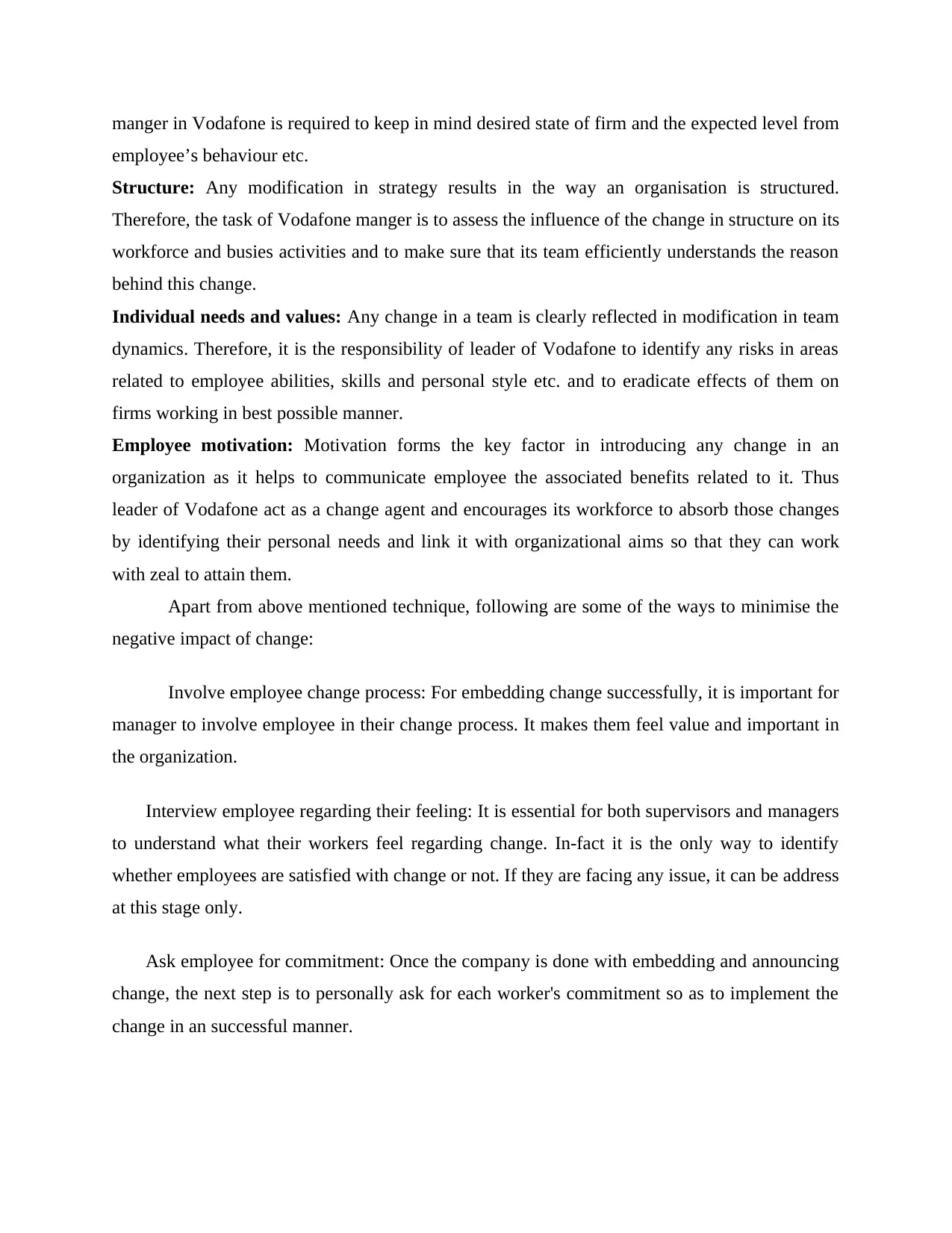
manger in Vodafone is required to keep in mind desired state of firm and the expected level from
employee’s behaviour etc.
Structure: Any modification in strategy results in the way an organisation is structured.
Therefore, the task of Vodafone manger is to assess the influence of the change in structure on its
workforce and busies activities and to make sure that its team efficiently understands the reason
behind this change.
Individual needs and values: Any change in a team is clearly reflected in modification in team
dynamics. Therefore, it is the responsibility of leader of Vodafone to identify any risks in areas
related to employee abilities, skills and personal style etc. and to eradicate effects of them on
firms working in best possible manner.
Employee motivation: Motivation forms the key factor in introducing any change in an
organization as it helps to communicate employee the associated benefits related to it. Thus
leader of Vodafone act as a change agent and encourages its workforce to absorb those changes
by identifying their personal needs and link it with organizational aims so that they can work
with zeal to attain them.
Apart from above mentioned technique, following are some of the ways to minimise the
negative impact of change:
Involve employee change process: For embedding change successfully, it is important for
manager to involve employee in their change process. It makes them feel value and important in
the organization.
Interview employee regarding their feeling: It is essential for both supervisors and managers
to understand what their workers feel regarding change. In-fact it is the only way to identify
whether employees are satisfied with change or not. If they are facing any issue, it can be address
at this stage only.
Ask employee for commitment: Once the company is done with embedding and announcing
change, the next step is to personally ask for each worker's commitment so as to implement the
change in an successful manner.
employee’s behaviour etc.
Structure: Any modification in strategy results in the way an organisation is structured.
Therefore, the task of Vodafone manger is to assess the influence of the change in structure on its
workforce and busies activities and to make sure that its team efficiently understands the reason
behind this change.
Individual needs and values: Any change in a team is clearly reflected in modification in team
dynamics. Therefore, it is the responsibility of leader of Vodafone to identify any risks in areas
related to employee abilities, skills and personal style etc. and to eradicate effects of them on
firms working in best possible manner.
Employee motivation: Motivation forms the key factor in introducing any change in an
organization as it helps to communicate employee the associated benefits related to it. Thus
leader of Vodafone act as a change agent and encourages its workforce to absorb those changes
by identifying their personal needs and link it with organizational aims so that they can work
with zeal to attain them.
Apart from above mentioned technique, following are some of the ways to minimise the
negative impact of change:
Involve employee change process: For embedding change successfully, it is important for
manager to involve employee in their change process. It makes them feel value and important in
the organization.
Interview employee regarding their feeling: It is essential for both supervisors and managers
to understand what their workers feel regarding change. In-fact it is the only way to identify
whether employees are satisfied with change or not. If they are facing any issue, it can be address
at this stage only.
Ask employee for commitment: Once the company is done with embedding and announcing
change, the next step is to personally ask for each worker's commitment so as to implement the
change in an successful manner.
⊘ This is a preview!⊘
Do you want full access?
Subscribe today to unlock all pages.

Trusted by 1+ million students worldwide
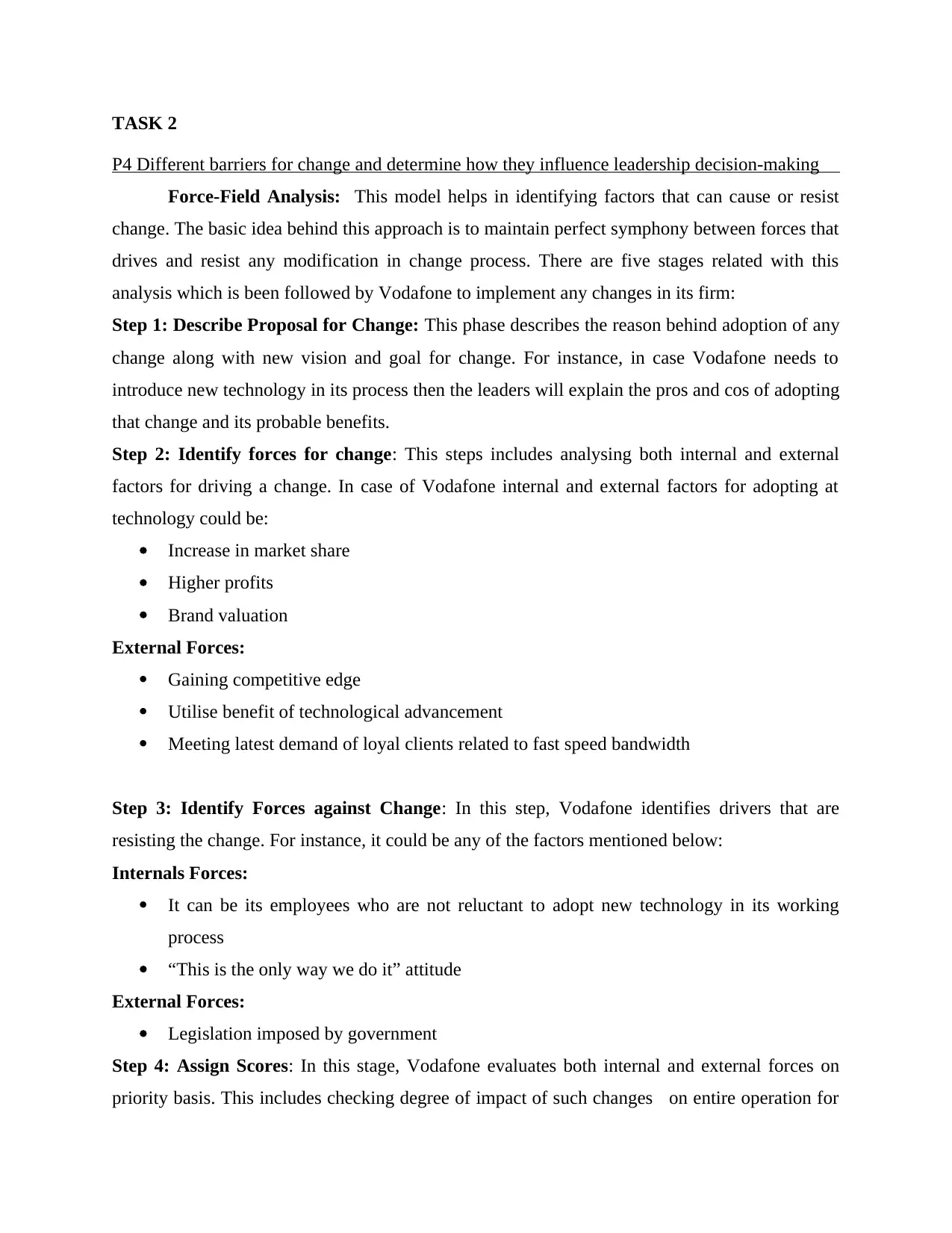
TASK 2
P4 Different barriers for change and determine how they influence leadership decision-making
Force-Field Analysis: This model helps in identifying factors that can cause or resist
change. The basic idea behind this approach is to maintain perfect symphony between forces that
drives and resist any modification in change process. There are five stages related with this
analysis which is been followed by Vodafone to implement any changes in its firm:
Step 1: Describe Proposal for Change: This phase describes the reason behind adoption of any
change along with new vision and goal for change. For instance, in case Vodafone needs to
introduce new technology in its process then the leaders will explain the pros and cos of adopting
that change and its probable benefits.
Step 2: Identify forces for change: This steps includes analysing both internal and external
factors for driving a change. In case of Vodafone internal and external factors for adopting at
technology could be:
Increase in market share
Higher profits
Brand valuation
External Forces:
Gaining competitive edge
Utilise benefit of technological advancement
Meeting latest demand of loyal clients related to fast speed bandwidth
Step 3: Identify Forces against Change: In this step, Vodafone identifies drivers that are
resisting the change. For instance, it could be any of the factors mentioned below:
Internals Forces:
It can be its employees who are not reluctant to adopt new technology in its working
process
“This is the only way we do it” attitude
External Forces:
Legislation imposed by government
Step 4: Assign Scores: In this stage, Vodafone evaluates both internal and external forces on
priority basis. This includes checking degree of impact of such changes on entire operation for
P4 Different barriers for change and determine how they influence leadership decision-making
Force-Field Analysis: This model helps in identifying factors that can cause or resist
change. The basic idea behind this approach is to maintain perfect symphony between forces that
drives and resist any modification in change process. There are five stages related with this
analysis which is been followed by Vodafone to implement any changes in its firm:
Step 1: Describe Proposal for Change: This phase describes the reason behind adoption of any
change along with new vision and goal for change. For instance, in case Vodafone needs to
introduce new technology in its process then the leaders will explain the pros and cos of adopting
that change and its probable benefits.
Step 2: Identify forces for change: This steps includes analysing both internal and external
factors for driving a change. In case of Vodafone internal and external factors for adopting at
technology could be:
Increase in market share
Higher profits
Brand valuation
External Forces:
Gaining competitive edge
Utilise benefit of technological advancement
Meeting latest demand of loyal clients related to fast speed bandwidth
Step 3: Identify Forces against Change: In this step, Vodafone identifies drivers that are
resisting the change. For instance, it could be any of the factors mentioned below:
Internals Forces:
It can be its employees who are not reluctant to adopt new technology in its working
process
“This is the only way we do it” attitude
External Forces:
Legislation imposed by government
Step 4: Assign Scores: In this stage, Vodafone evaluates both internal and external forces on
priority basis. This includes checking degree of impact of such changes on entire operation for
Paraphrase This Document
Need a fresh take? Get an instant paraphrase of this document with our AI Paraphraser
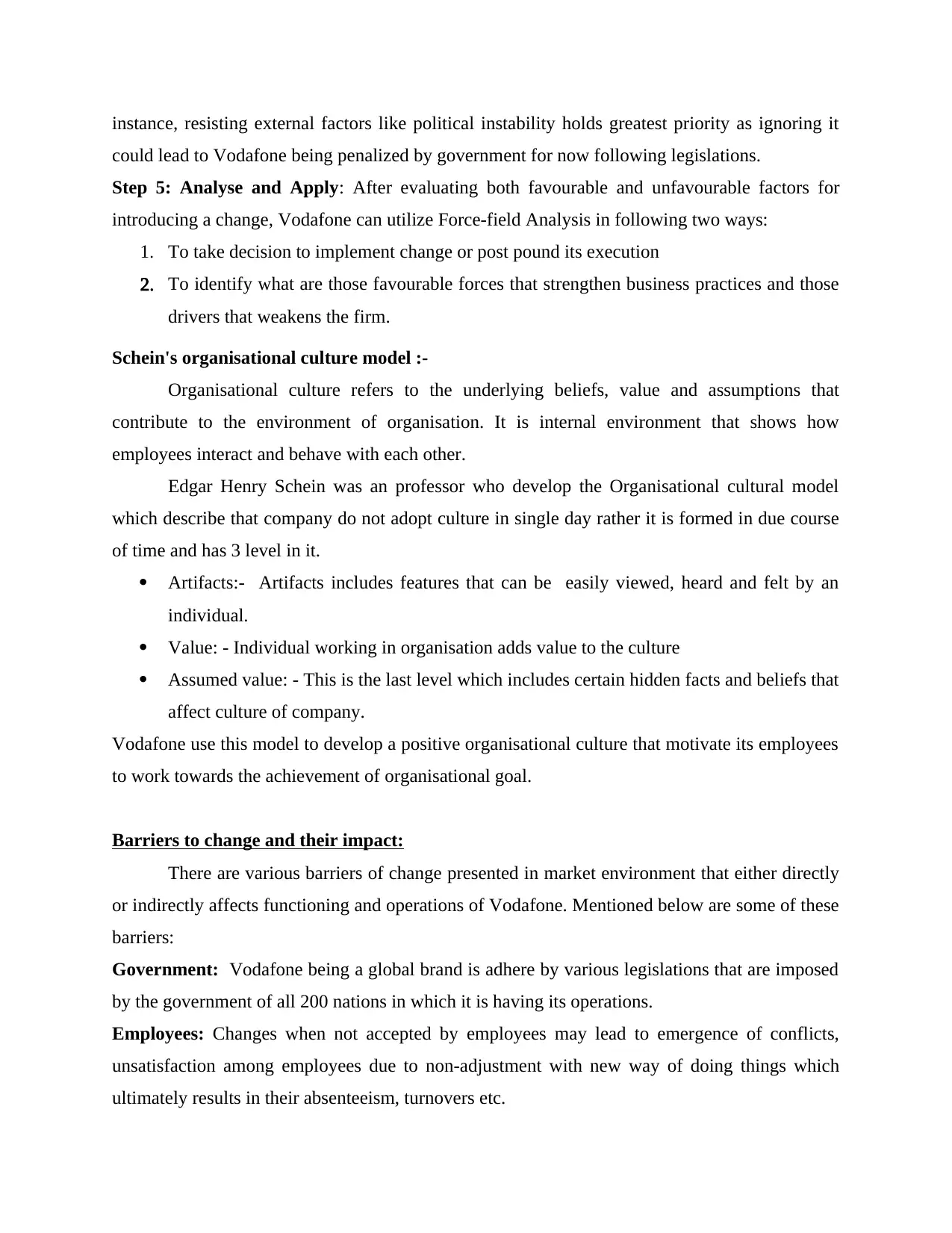
instance, resisting external factors like political instability holds greatest priority as ignoring it
could lead to Vodafone being penalized by government for now following legislations.
Step 5: Analyse and Apply: After evaluating both favourable and unfavourable factors for
introducing a change, Vodafone can utilize Force-field Analysis in following two ways:
1. To take decision to implement change or post pound its execution
2. To identify what are those favourable forces that strengthen business practices and those
drivers that weakens the firm.
Schein's organisational culture model :-
Organisational culture refers to the underlying beliefs, value and assumptions that
contribute to the environment of organisation. It is internal environment that shows how
employees interact and behave with each other.
Edgar Henry Schein was an professor who develop the Organisational cultural model
which describe that company do not adopt culture in single day rather it is formed in due course
of time and has 3 level in it.
Artifacts:- Artifacts includes features that can be easily viewed, heard and felt by an
individual.
Value: - Individual working in organisation adds value to the culture
Assumed value: - This is the last level which includes certain hidden facts and beliefs that
affect culture of company.
Vodafone use this model to develop a positive organisational culture that motivate its employees
to work towards the achievement of organisational goal.
Barriers to change and their impact:
There are various barriers of change presented in market environment that either directly
or indirectly affects functioning and operations of Vodafone. Mentioned below are some of these
barriers:
Government: Vodafone being a global brand is adhere by various legislations that are imposed
by the government of all 200 nations in which it is having its operations.
Employees: Changes when not accepted by employees may lead to emergence of conflicts,
unsatisfaction among employees due to non-adjustment with new way of doing things which
ultimately results in their absenteeism, turnovers etc.
could lead to Vodafone being penalized by government for now following legislations.
Step 5: Analyse and Apply: After evaluating both favourable and unfavourable factors for
introducing a change, Vodafone can utilize Force-field Analysis in following two ways:
1. To take decision to implement change or post pound its execution
2. To identify what are those favourable forces that strengthen business practices and those
drivers that weakens the firm.
Schein's organisational culture model :-
Organisational culture refers to the underlying beliefs, value and assumptions that
contribute to the environment of organisation. It is internal environment that shows how
employees interact and behave with each other.
Edgar Henry Schein was an professor who develop the Organisational cultural model
which describe that company do not adopt culture in single day rather it is formed in due course
of time and has 3 level in it.
Artifacts:- Artifacts includes features that can be easily viewed, heard and felt by an
individual.
Value: - Individual working in organisation adds value to the culture
Assumed value: - This is the last level which includes certain hidden facts and beliefs that
affect culture of company.
Vodafone use this model to develop a positive organisational culture that motivate its employees
to work towards the achievement of organisational goal.
Barriers to change and their impact:
There are various barriers of change presented in market environment that either directly
or indirectly affects functioning and operations of Vodafone. Mentioned below are some of these
barriers:
Government: Vodafone being a global brand is adhere by various legislations that are imposed
by the government of all 200 nations in which it is having its operations.
Employees: Changes when not accepted by employees may lead to emergence of conflicts,
unsatisfaction among employees due to non-adjustment with new way of doing things which
ultimately results in their absenteeism, turnovers etc.
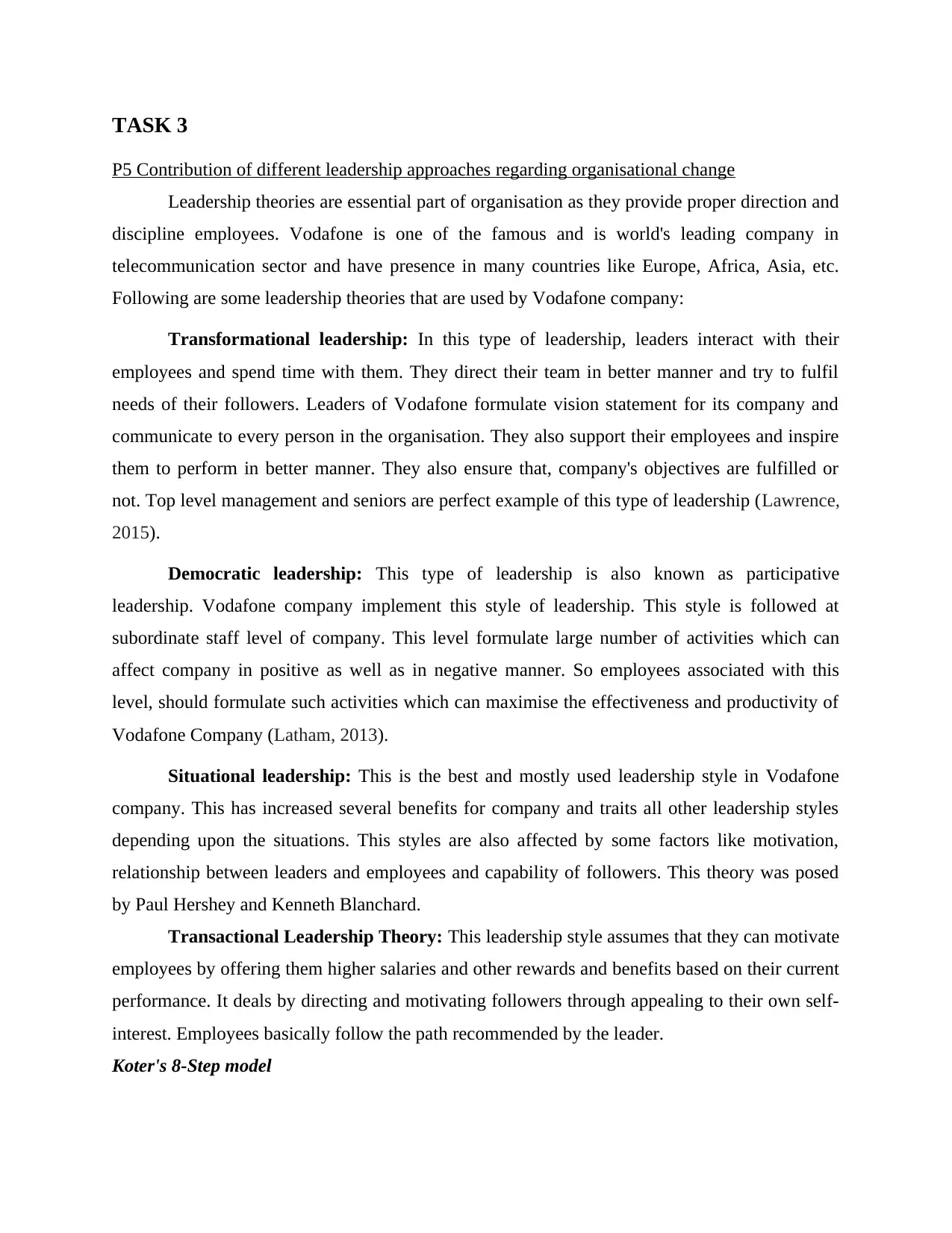
TASK 3
P5 Contribution of different leadership approaches regarding organisational change
Leadership theories are essential part of organisation as they provide proper direction and
discipline employees. Vodafone is one of the famous and is world's leading company in
telecommunication sector and have presence in many countries like Europe, Africa, Asia, etc.
Following are some leadership theories that are used by Vodafone company:
Transformational leadership: In this type of leadership, leaders interact with their
employees and spend time with them. They direct their team in better manner and try to fulfil
needs of their followers. Leaders of Vodafone formulate vision statement for its company and
communicate to every person in the organisation. They also support their employees and inspire
them to perform in better manner. They also ensure that, company's objectives are fulfilled or
not. Top level management and seniors are perfect example of this type of leadership (Lawrence,
2015).
Democratic leadership: This type of leadership is also known as participative
leadership. Vodafone company implement this style of leadership. This style is followed at
subordinate staff level of company. This level formulate large number of activities which can
affect company in positive as well as in negative manner. So employees associated with this
level, should formulate such activities which can maximise the effectiveness and productivity of
Vodafone Company (Latham, 2013).
Situational leadership: This is the best and mostly used leadership style in Vodafone
company. This has increased several benefits for company and traits all other leadership styles
depending upon the situations. This styles are also affected by some factors like motivation,
relationship between leaders and employees and capability of followers. This theory was posed
by Paul Hershey and Kenneth Blanchard.
Transactional Leadership Theory: This leadership style assumes that they can motivate
employees by offering them higher salaries and other rewards and benefits based on their current
performance. It deals by directing and motivating followers through appealing to their own self-
interest. Employees basically follow the path recommended by the leader.
Koter's 8-Step model
P5 Contribution of different leadership approaches regarding organisational change
Leadership theories are essential part of organisation as they provide proper direction and
discipline employees. Vodafone is one of the famous and is world's leading company in
telecommunication sector and have presence in many countries like Europe, Africa, Asia, etc.
Following are some leadership theories that are used by Vodafone company:
Transformational leadership: In this type of leadership, leaders interact with their
employees and spend time with them. They direct their team in better manner and try to fulfil
needs of their followers. Leaders of Vodafone formulate vision statement for its company and
communicate to every person in the organisation. They also support their employees and inspire
them to perform in better manner. They also ensure that, company's objectives are fulfilled or
not. Top level management and seniors are perfect example of this type of leadership (Lawrence,
2015).
Democratic leadership: This type of leadership is also known as participative
leadership. Vodafone company implement this style of leadership. This style is followed at
subordinate staff level of company. This level formulate large number of activities which can
affect company in positive as well as in negative manner. So employees associated with this
level, should formulate such activities which can maximise the effectiveness and productivity of
Vodafone Company (Latham, 2013).
Situational leadership: This is the best and mostly used leadership style in Vodafone
company. This has increased several benefits for company and traits all other leadership styles
depending upon the situations. This styles are also affected by some factors like motivation,
relationship between leaders and employees and capability of followers. This theory was posed
by Paul Hershey and Kenneth Blanchard.
Transactional Leadership Theory: This leadership style assumes that they can motivate
employees by offering them higher salaries and other rewards and benefits based on their current
performance. It deals by directing and motivating followers through appealing to their own self-
interest. Employees basically follow the path recommended by the leader.
Koter's 8-Step model
⊘ This is a preview!⊘
Do you want full access?
Subscribe today to unlock all pages.

Trusted by 1+ million students worldwide
1 out of 16
Related Documents
Your All-in-One AI-Powered Toolkit for Academic Success.
+13062052269
info@desklib.com
Available 24*7 on WhatsApp / Email
![[object Object]](/_next/static/media/star-bottom.7253800d.svg)
Unlock your academic potential
Copyright © 2020–2025 A2Z Services. All Rights Reserved. Developed and managed by ZUCOL.



